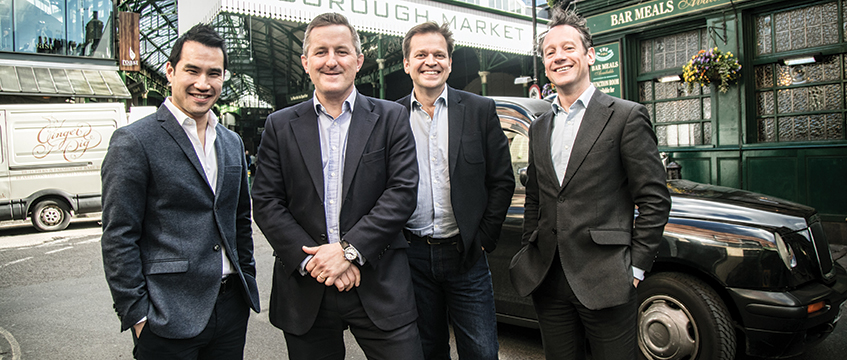Nothing says SE1 like an office above Monmouth Coffee Company overlooking Borough Market. Throw in a bright, airy warehouse-style interior and the South Bank brand is complete; this is Union Street Partners’ ’hood. And they have the £20-a-week organic sausage roll habit to prove it.
“Having the office here in the middle of SE1 is exactly what we needed to cement ourselves as a local adviser,” says leasing and development partner Jules Hind. “We trade mercilessly on the fact that we are a pure South Bank business. It has taken the rest of the industry a while to get used to the model. But we would argue it is insanely simple.”
Simple, maybe. But the USP set-up is unusual. The three-year-old spin off agency is a product of a 50:50 joint venture launch by niche agents Farebrother and Tuckerman. The new firm runs alongside the original two businesses with a targeted focus on SE1 and fringe areas including Vauxhall, SE11, SE17, and Nine Elms, Battersea Power Station, SW8. The new venture is effectively a vehicle to capitalise on an increasingly active geographical market – one that has attracted £4.8bn investment into the offices and retail markets over the past three years.
Run by Farebrother leasing and development directors Hind and Mark Anstey, and Tuckerman managing director Mark Fisher and valuation director Alex Lewis, the eight-strong core team is as lean as they come. But that hasn’t stopped them from pulling off a David and Goliath-style turn in the area as USP topped the southern fringe agent league in EG’s Q4 2016 London Offices Market Analysis. Beating agency giants Cushman & Wakefield, CBRE and JLL to the top spot, the group secured a 49% market share for the quarter with eight deals just under 160,000 sq ft.
Granular market
But in a granular market where small sites are the norm the further you move away from Battersea and Vauxhall, are there enough opportunities to keep piquing investor and developer interest? And as global occupiers such as Apple move in and bolster the cache of uptake south of the river, will such a small spin-off agency have what it takes to hold on to its crown?
First off, the USP founders are quick to point out they are not as small as they might look at first glance. The core team is just over half a dozen, but includes a number of key hires such as Simon Smith and Rupert Cowling from CBRE back in May 2015 along with Vincent Cheung from Kalmars. The firm also has access to a team of 60 across the two original businesses. “We have around 25 agents across the two firms we can draw on,” says investment partner Mark Fisher. “Every one of them has a dual role where they are and also working here. It is an unusual arrangement, but as a business model we think it really works.”
And as for concerns over the granular market in the heart of SE1? The solution is diversification: “It is not only about SE1, just as it is not only about the riverfront locations,” says Hind, pinpointing the areas in question on a wall map so vast he eventually employs a spare pool cue to reach anything north of Blackfriars. “We added SE11, SE17, everything around Elephant & Castle, obviously Vauxhall and everything east of there down to Battersea.”
Existing expertise
It is a fair whack of London real estate. Swathes of land in which, between the two original firms, they have the benefit of existing expertise. “Four years ago when we were thinking about setting USP up we had a book of work each,” says Fisher. “At Tuckerman we tend to stick around the Victoria heart line – so Vauxhall to Waterloo. And Farebrother historically had been Bankside, which is basically Waterloo down to London Bridge and Tower Bridge. So there was a natural meeting point around Waterloo and no conflict.
“There is 25m sq ft to play with here. That’s growing all the time with more coming online down at Battersea and Nine Elms constantly, and that’s why we decided the South Bank deserved its own brand and its own local adviser. But we know that by being so niche there is always a risk from other players wanting to infiltrate the market. So we are always moving on to the next areas as others reach maturity. Victoria, for example, has just about reached maturity with Nova there now. It is getting to the point where there isn’t as much to do for a company like ours. But over here there is so much going on. Floor plates of 3,000 to 10,000 sq ft are plentiful and the fragmented ownership is a benefit. In somewhere like Victoria, Land Securities and Grosvenor have that pretty much covered. Down here there are lots of opportunities for site assemblies.”
In Q4 of last year USP research identified 744,264 sq ft of South Bank stock and a 3.6% availability rate. Out of a total take-up in Q4 of 415,724 sq ft, 35% of that went to DAMITT (design, advertising, media, internet, technology and telecoms) occupiers. Investment into the area in the same quarter was £132.8m – 84% of which was made up of domestic funds.
The team predicts that an influx of retail occupiers and improved infrastructure in what has been a traditionally impermeable area should boost investment figures and potentially attract more tech occupiers and overseas interest.
“There is still a real permeability issue,” says Hind. “Not long ago you just couldn’t get from Tooley Street to St Thomas Street – or from the north to south of London Bridge station – very easily, but it is all opening up now.”
Walkable route
Fisher adds that the Low Line – Bankside’s answer to the High Line in New York – should also help. By turning the space under the railway line into a walkable route, pedestrians and commuters will soon be able to walk from Waterloo to London Bridge via the new line: “This has meant the appetite from commercial developers and investors has jumped across to the south side of the railway, which it didn’t for years, “ he says. “It was very much a psychological barrier.
“But now we are seeing mainstream funds investing in small pockets of land in the backwaters of south London. CBRE GI and Henderson have been looking at buildings of 3m to 5m sq ft which is probably below people’s perception of what a normal lot size might be. But they are looking for yield which has been difficult to find elsewhere.”
“A classic South Bank building is a converted warehouse,” says partner Rupert Cowling. “We are currently working on two of about 20,000 sq ft each for CBRE GI.”
But he adds that the real boost for the area will come in the form of an upgraded retail offer: “ Quite rightly a lot of office occupiers have been moving down here,” he says. “A lot of new bars and restaurants have followed suit. But retail is one of the things that this area has really lacked and, actually, probably continues to lack. That will change. There is three quarters of a million sq ft of retail planned around the old Vinopolis site. Plans went through last year and it is now in demolition phase.

Photographs by Jon Enoch
“The issue with some of the areas we are known for working in, like Victoria, is that retail is a five day trade,” adds Hind. “Here it is buzzing seven days a week.”
Also on the South Bank’s side is the fact that it is proving relatively easy for developers to switch their consents back from residential to commercial: “With Southwark and Lambeth councils its an open door,” says Hind. “Pushing stock back to rate paying commercial occupiers? They love it.”
But as global occupier giants like Apple, the US Embassy and WeWork continue to make the leap over the Thames, attracted by the South Bank’s growing reputation as a serious commercial contender, USP knows the time to be looking for the next opportunity area is now.
“We are looking at areas that have a reputation they don’t necessarily deserve,” says Fisher. “Places like Millwall and Deptford. We don’t want to expand so much we become unfocussed. The geographical pinpointing is proving so successful. But we are niche. We know there is always a risk of someone else swooping in and we know we have to move fast to be ahead of the pack.”
To send feedback, e-mail emily.wright@egi.co.uk or tweet @EmilyW_9 or @estatesgazette











